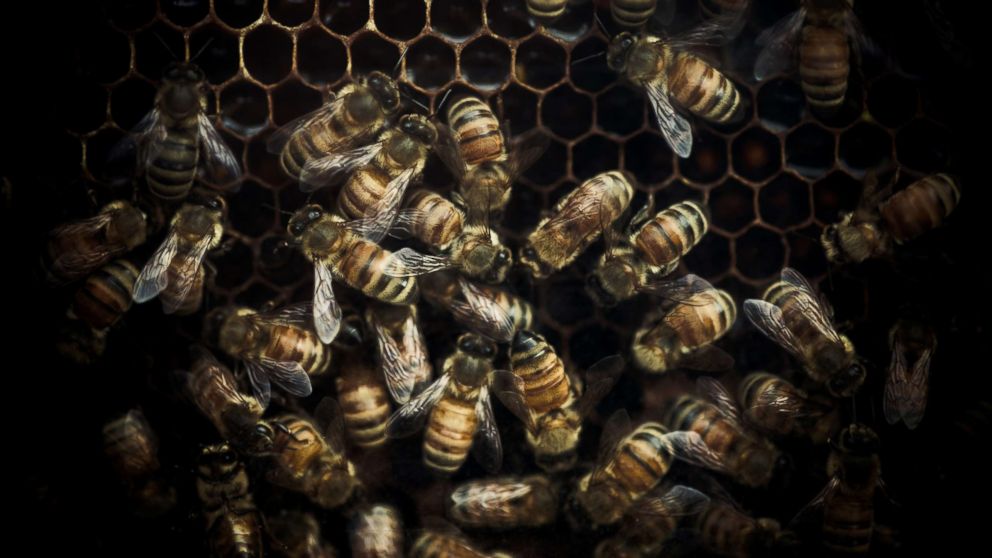


We have bad news for you. You probably don't know much about escaping bees.
There's a world of misinformation out there, and after two horrifying bee attack incidents in New Hampshire and California this week, it's time to start clearing some things up.
ABC News spoke to Dr. Justin O. Schmidt, an entomologist with expertise in stinging insects and arthropods, to find out what people need to know about bees.
1) If a bee "bumps into" you, it's not an accident. Run.
If a colony of bees thinks you're a predator, it first sends out a few guard bees to warn you away by "head butting" you, according to a guide by the U.S. Department of the Interior National Park Service's Saguaro National Park.
If you feel a "head butt," run, because the next thing that comes is a full-scale attack by the entire hive.
In fact, with bees, your most primal instinct - to run - is always exactly the right one.
"Don't hesitate. Don't fight them. All you're going to do is give them time to get hundreds and thousands more. Just get out of there," said Schmidt.
2) If there's no attack yet, hold your breath. No, literally. Hold your breath.
Bees’ primary sense is smell, said Schmidt. “They navigate the world through odor,” he noted.
Holding your breath won’t exactly help when there’s a whole swarm on you, but it might give you some time to get away if only a few bees are hovering.
"If you take that away, you are making them blind, so to speak," he said. "It’s almost like you are invisible to them.”
3) Don’t flail your arms and don’t swat.
Most people’s immediate response to a nearby bee is to brush it off or to shoo it. Unfortunately, to the bee, that doesn’t signal so much “go away” as it does “big angry predator coming to attack."
“When you see a bee buzzing near your head, I know it's very satisfying to flap your arms,” said Schmidt.
He added, “It just feels so good to swat at it - don't do it! Bad news! It’ll make everything worse. The bees feel threatened and their natural response is to rise up together and defend their queen.”
And no, it doesn’t help if you kill an attacking bee. According to the Saguaro National Park guide, a killed bee gives off an “alarm scent” that will only serve to call its hive-mates to the scene of the crime.
4) Forget what you've heard about the dangers of pulling the stinger out. Just do it.
Conventional wisdom says you must scrape the stinger off your skin with something that has a flat surface like a credit card or a butter knife or a pair of tweezers. Don't try to pull it out with your fingers, we've been told, because then you'll press the bulb at the end of it and force the venom into your skin faster.
That's a myth, Schmidt said. And a dangerous one at that, because you could waste valuable seconds looking for something flat to scrape it out with.
"When you get stung, you don't have time to futz around with a wallet to find a credit card," he said.
"Just get it out. Pull it out, rub it out, pinch it out," he went on. "It doesn't matter. All that matters is that you remove it as fast as possible because the more time it stays in there, the more venom enters your body."
If you are allergic to bee venom, keep an EpiPen handy and contact a medical professional immediately.
5) Not all honey bees are dying out. The dangerous ones are thriving, so keep an exterminator on speed dial.
If you live somewhere in New Mexico, Southern California, Arizona, Texas or Florida, you can pretty much assume that there are "killer bees" or Africanized honey bees somewhere close to you.
Africanized honey bees, which escaped from Brazil and arrived in the United States in the 1990s, are easily distinguished by how very ferociously they defend their hive.
"They're like a kid on steroids," Schmidt said.
They swarm in larger numbers and attack at slight provocations. They do look slightly different from the far more docile European honey bees but don't bother trying to tell the two apart before you start to back away. Their most discernible difference is their behavior, and by the time you figure that out, it might be too late.
"It's kind of like you see two people on the street. One might be a mugger and one might be a saint but they don't look all that different," said Schmidt.
Because of their more aggressive defense mechanisms and because they reproduce so much faster, there's no evidence that these bees have been affected by the Colony Collapse Disorder that has nearly killed off the U.S. honey bee population.
Nicole Sorenson of Bee Busters, a bee removal company that was called in after the incident in California where a woman was stung 200 times and hospitalized, said residents are often hesitant to call.
"It's very hard to explain to a lot of our customers who want to save the bees that these are the kind of bees that do exactly what happened to this woman. It's very important to call somebody any time you see any kind of bee activity," she said.